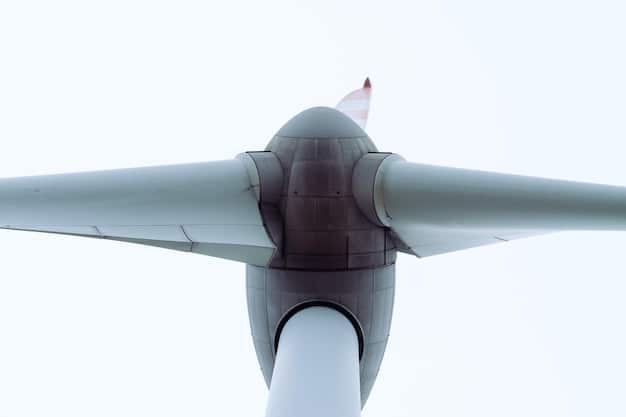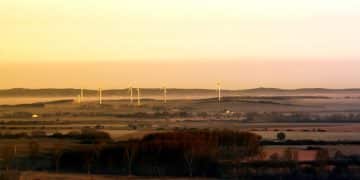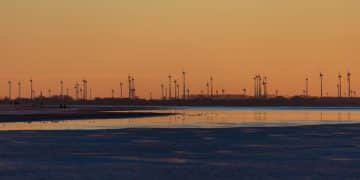Promising Innovations in US Wind Turbine Technology for Efficiency

Several innovations in US wind turbine technology, like larger rotor diameters, higher hub heights, advanced materials, and smart grid integration, promise significant gains in efficiency and energy production.
The United States has been making significant strides in wind energy, with numerous technological advancements aimed at boosting efficiency. This article delves into the most promising innovations in US wind turbine technology for increased efficiency, exploring how these developments are shaping the future of clean energy.
Advanced Materials in Wind Turbines
One of the most notable areas of innovation in wind turbine technology is the use of advanced materials. These materials are designed to be lighter, stronger, and more durable, allowing for the creation of larger and more efficient wind turbines.
Advanced materials are crucial for increasing the performance and reliability of wind turbines. Researchers and manufacturers are continuously exploring new materials to push the boundaries of what is possible.
High-Strength Composites
High-strength composites, such as carbon fiber and fiberglass, are increasingly being used in wind turbine blades. These materials offer an excellent strength-to-weight ratio, making it possible to produce longer blades that can capture more wind energy.
The use of composites allows for the creation of blades that are not only lighter but also more resistant to fatigue and corrosion. This leads to a longer lifespan and reduced maintenance costs.
Self-Healing Materials
Self-healing materials are another exciting development in wind turbine technology. These materials can automatically repair minor damage, extending the lifespan of the turbine components and reducing the need for frequent inspections and repairs.
By incorporating self-healing capabilities, wind turbines can maintain their performance over longer periods, even in harsh environmental conditions.
- Benefits of Advanced Materials: Increased energy capture, reduced weight, and improved durability.
- Challenges: High initial cost and the need for specialized manufacturing processes.
- Future Trends: Development of even stronger and lighter materials, as well as materials with integrated sensors for real-time monitoring.

The integration of these advanced materials is a game-changer for the wind energy industry, opening up new possibilities for turbine design and performance. As material science continues to advance, we can expect even more innovative solutions that further enhance the efficiency and reliability of wind turbines.
Larger Rotor Diameters and Higher Hub Heights
Increasing the size of wind turbines is a direct way to improve their energy capture capabilities. Larger rotor diameters and higher hub heights allow turbines to harness more wind energy, especially in areas with lower wind speeds.
The trend towards larger turbines is driven by the desire to maximize energy production from each turbine, making wind farms more efficient and cost-effective.
Benefits of Larger Rotors
Larger rotor diameters mean that the turbine blades sweep a larger area, capturing more of the available wind energy. This is particularly beneficial in regions where the wind speed is not consistently high.
With larger rotors, turbines can generate more electricity even in moderate wind conditions, making wind energy a more reliable and predictable source of power.
Advantages of Higher Hub Heights
Higher hub heights allow turbines to reach stronger and more consistent winds. At higher altitudes, the wind is less affected by obstacles such as trees and buildings, resulting in a more stable and predictable energy source.
By placing turbines on taller towers, wind farm operators can tap into wind resources that would otherwise be inaccessible, further boosting energy production.
- Increased Energy Production: Larger rotor diameters and higher hub heights result in significantly more energy capture.
- Improved Site Utilization: Larger turbines can generate more power from a smaller footprint, optimizing land use.
- Challenges: Logistical difficulties in transporting and installing larger components, as well as potential visual impact concerns.
The combination of larger rotor diameters and higher hub heights is a key strategy for enhancing the performance of wind turbines and making wind energy a more competitive alternative to fossil fuels. As technology continues to evolve, we can expect to see even taller and more powerful turbines being deployed in wind farms across the US.
Smart Grid Integration Technologies
Integrating wind energy into the power grid requires advanced technologies that can manage the fluctuating nature of wind power. Smart grid technologies play a crucial role in ensuring that wind energy is a reliable and stable source of electricity.
These technologies help to smooth out the variability of wind power, making it easier to integrate into the grid and meet the energy demands of consumers.
Advanced Forecasting Systems
Accurate wind forecasting is essential for managing the variability of wind energy. Advanced forecasting systems use sophisticated weather models and real-time data to predict wind patterns and estimate energy production.
By having reliable forecasts, grid operators can make informed decisions about how to allocate resources and ensure that the grid remains stable and balanced.
Energy Storage Solutions
Energy storage technologies, such as batteries and pumped hydro storage, can help to store excess wind energy and release it when demand is high. This helps to smooth out the variability of wind power and make it a more reliable source of electricity.
Energy storage solutions are becoming increasingly important as the share of wind energy in the grid continues to grow, providing a buffer against fluctuations in wind power generation.
- Improved Grid Stability: Smart grid technologies help to smooth out the variability of wind power.
- Enhanced Reliability: Energy storage solutions ensure that wind energy is available when needed.
- Challenges: High costs associated with energy storage and the need for advanced control systems.
Smart grid integration technologies are critical for unlocking the full potential of wind energy. As these technologies continue to advance, wind power will become an even more reliable and cost-effective source of clean energy.
Innovative Blade Designs
The design of wind turbine blades is a critical factor in determining how efficiently a turbine can capture wind energy. Innovative blade designs are constantly being developed to improve performance and reduce noise.
These designs focus on optimizing the shape and structure of the blades to maximize energy capture while minimizing aerodynamic drag and noise.
Twisted Blade Geometry
Twisted blade geometry is a design feature that optimizes the angle of the blade along its length. This helps to ensure that the blade captures the maximum amount of wind energy, regardless of the wind speed or direction.
By carefully adjusting the twist angle, engineers can fine-tune the performance of the blade and improve its overall efficiency.
Serrated Trailing Edges
Serrated trailing edges are a design feature that reduces the noise generated by wind turbine blades. These edges break up the airflow as it passes over the blade, minimizing the turbulence that causes noise.
By reducing noise, serrated trailing edges help to make wind farms more acceptable to local communities, paving the way for wider adoption of wind energy.

- Enhanced Energy Capture: Innovative blade designs maximize the amount of wind energy that can be captured.
- Reduced Noise: Serrated trailing edges minimize the noise generated by wind turbines.
- Challenges: Complex manufacturing processes and the need for careful aerodynamic optimization.
Innovative blade designs are essential for ensuring that wind turbines operate as efficiently and quietly as possible. As these designs continue to evolve, they will play a key role in making wind energy a more sustainable and widely accepted source of power.
Direct-Drive Generators
Traditional wind turbines use a gearbox to increase the rotational speed of the rotor before it is fed into the generator. Direct-drive generators eliminate the need for a gearbox, reducing maintenance costs and improving reliability.
Direct-drive generators are a significant advancement in wind turbine technology, offering several advantages over traditional geared systems.
Reduced Maintenance Costs
Gearboxes are a common source of failure in wind turbines, requiring frequent maintenance and repairs. By eliminating the gearbox, direct-drive generators significantly reduce maintenance costs and downtime.
This makes wind turbines with direct-drive generators more cost-effective over their lifespan, as they require less frequent and less extensive maintenance.
Improved Reliability
Direct-drive generators are generally more reliable than geared systems, as they have fewer moving parts. This reduces the risk of mechanical failure and extends the lifespan of the turbine.
By improving reliability, direct-drive generators help to ensure that wind turbines operate consistently over long periods, providing a more stable and predictable source of energy.
- Lower Maintenance: Direct-drive generators eliminate the need for a gearbox, reducing maintenance requirements.
- Increased Reliability: Fewer moving parts result in a more reliable turbine.
- Challenges: Higher initial cost and the need for larger and heavier generators.
Direct-drive generators are a promising development in wind turbine technology, offering significant benefits in terms of maintenance and reliability. As the technology continues to evolve, we can expect to see more wind turbines with direct-drive generators being deployed in wind farms across the US.
Floating Wind Turbines
Floating wind turbines are designed to be deployed in deepwater locations where fixed-bottom turbines are not feasible. This opens up new opportunities for wind energy development in areas with strong and consistent winds.
Floating wind turbines are revolutionizing the wind energy industry, allowing for the exploitation of offshore wind resources in deeper waters.
Access to Untapped Wind Resources
Floating wind turbines can be deployed in areas with stronger and more consistent winds, as they are not limited by water depth. This allows for the exploitation of untapped wind resources that would otherwise be inaccessible.
By tapping into these resources, floating wind turbines can generate significantly more energy than fixed-bottom turbines, making them a valuable addition to the wind energy portfolio.
Reduced Environmental Impact
Floating wind turbines can be deployed further offshore, reducing their visual impact on coastal communities. This can help to address concerns about the aesthetic impact of wind farms and make them more acceptable to local residents.
Additionally, floating wind turbines have a lower environmental impact on marine ecosystems, as they do not require the installation of foundations on the seabed.
- Access to Deepwater Resources: Floating wind turbines can be deployed in areas where fixed-bottom turbines are not feasible.
- Reduced Visual Impact: Turbines can be located further offshore, minimizing their visual impact on coastal communities.
- Challenges: Higher installation and maintenance costs, as well as the need for specialized mooring and anchoring systems.
Floating wind turbines are a game-changer for the wind energy industry, opening up new possibilities for offshore wind development. As the technology continues to mature, we can expect to see more floating wind farms being deployed in deepwater locations around the world.
| Key Point | Brief Description |
|---|---|
| 💪 Advanced Materials | Lighter, stronger materials like carbon fiber enhance blade efficiency and lifespan. |
| ⬆️ Larger Turbine Size | Larger rotors and higher hubs capture more wind energy at greater altitudes. |
| 💡 Smart Grid Integration | Technologies like forecasting and energy storage stabilize wind power for grid reliability. |
| 🌊 Floating Turbines | Enable wind energy harvesting in deepwater locations with strong winds. |
FAQ
▼
Advanced materials, such as carbon fiber composites, reduce weight and increase strength, enabling larger blades that capture more wind energy. This increases efficiency and reduces maintenance costs.
▼
Larger rotors sweep a greater area, capturing more wind. Higher hub heights access stronger, more consistent winds, especially in areas with ground-level obstructions, increasing overall energy production.
▼
Smart grid technologies, including advanced forecasting and energy storage, manage the variability of wind power, ensuring a stable and reliable supply of electricity to meet consumer demands consistently.
▼
Direct-drive generators eliminate the gearbox, reducing maintenance and increasing reliability. This results in fewer breakdowns and lower operational costs, making wind energy more cost-effective overall.
▼
Floating wind turbines can be deployed in deepwater locations, accessing stronger and more consistent winds further offshore. This expands the potential for wind energy development away from coastal areas.
Conclusion
In conclusion, the innovations in US wind turbine technology are paving the way for a more efficient and sustainable energy future. By focusing on advanced materials, larger turbine designs, smart grid integration, and innovative technologies like floating wind turbines, the United States is positioned to lead the world in wind energy production.





